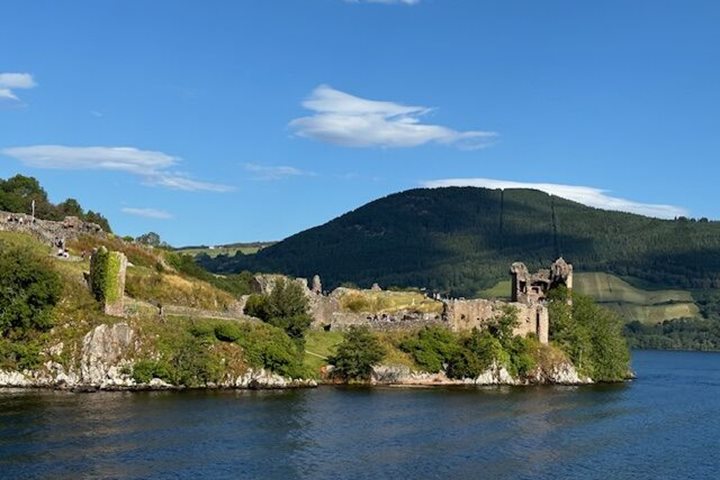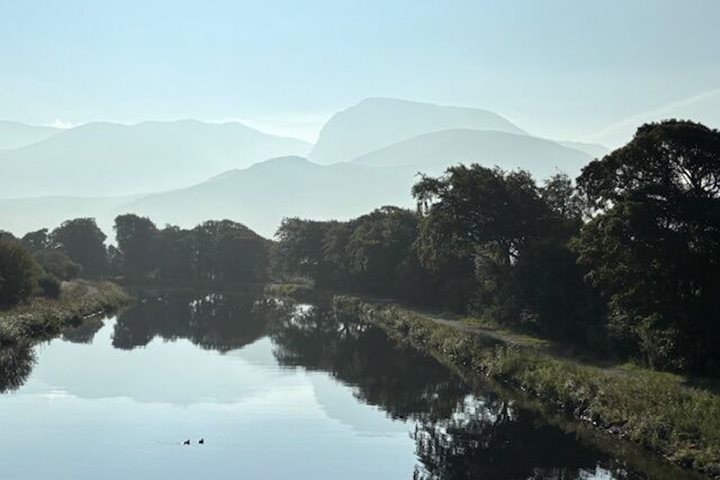At first light we were still moored up in Oban harbour alongside fishing trawlers, sailing boats, and the imposing Caledonian MacBrayne car ferries. During breakfast all were getting up steam, and we slipped moorings in turn, heading out into the Firth of Lorne. Our destination this morning is Craignure (“Crag of the Yew Tree” in Gaelic), the main port on Mull. Past the pure white lighthouse on Lismore (designed and built by Robert Louis Stevenson’s father), through the tide rips around the Lady Rock, and once tied up at the jetty on Mull, we quickly transferred to the bright red island bus awaiting us.
Mull is the third largest island off the coast of Scotland, but it has a population of only 3,000 people. An ancient volcano, with high peaks, grassy glens, forest, and lochs, it is one of the emptiest and loveliest of them all. Within minutes we were on the single-track road that traverses the mountains, drops to the long sea-loch of Loch Scredain, and heads west. Steve, the local bus driver, kept us entertained with his own unique brand of wit and wisdom while still negotiating perilous drops and oncoming traffic. The road winds along the seashore where herons stalk the creeks, beside lush pastures with grazing geese and sheep, and over narrow bridges above rushing streams. Then into the jumbled pink granite outcrops of the Ross of Mull and down to the tiny slipway at Fionnphort.
Here the ferry waits with ramp down, and once we’ve walked on board it is out across the turquoise waters of Iona Sound. By now the overcast skies of Oban and the scurrying clouds of Mull are past. As we walk ashore on Iona there is a cool breeze off the sea and blue skies: just one of the many miracles this tiny island bestows. Only three miles long by one wide, it has been occupied for 6,000 years, a Christian retreat for over 600, and world famous despite its remote location. St. Columba, a disillusioned warrior from Ireland, turned his back on violence and came here to immerse himself in the Christian faith. His example, his writings, and his personal charisma inspired disciples to take this message back through the Scottish mainland and out to France, Germany, Italy, and beyond, founding monasteries throughout Europe. Steve, our Expedition Leader, led us into the Abbey and summarized this extraordinary life and how the Abbey was restored. The island now supports spiritual endeavors around the world, and welcomes pilgrims likewise. After a climb to the highest point, Dun I (“The Fort of the Island” 332ft high) we retraced our steps to the ferry and thence rejoined our bus back across Mull. A brief diversion to the dramatic Duart Castle, perched on a black rock promontory above the sea, allowed us to see the ancestral home of the Clan Maclean and explore its carpeted halls and spiral staircases that wind all the way up to the battlements that dominate the seaways in and out of Mull.
The last leg of the day was up the Sound of Mull in a stiffening breeze to the sheltered haven of Tobermory and here, as a full moon rose above the bay, we attended a talk by the raptor charity “Wings over Mull,” which rehabilitates injured birds of prey. They showed us a Snowy Owl, Barn Owl, and Harris Hawk and explained their lifestyles as the birds perched in full view.







